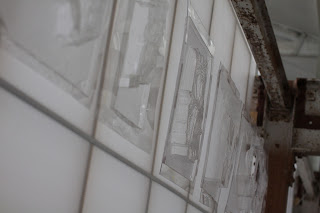 |
| Plaster cast model after a 'rain' event |
 |
| Digital model with simplified slopes |
 |
| (arduous) process of transforming the slopes to create 'gestural' formation |
The plaster cast models have enabled:
- An understanding of scale and the ‘carving’ process of both mining and re-grading within the open-cut
- Importance of retaining the hard edges for the sense of scale within the site as well as retaining a historical indication of how the site has been formed
- Water shedding collects in several area of the site: open-cut pondage, perimeter of OB and the wetlands
- I cannot objectively design how run-off into the open-cut will occur due to the scale of the site, but I can design to allow for it to alter the form over a course of time
The initial objective in sculpting the models was to develop a schematic for producing a master plan for a park that encompassed site boundary. The way in which I was considering the park was through access and the type of program, mainly walking or biking. Working with the models enabled me to grapple with the whole site and I discovered that not everything could be ‘designed’ at the extent of the site. From this I then questioned;
- What needs to be designed?
- How can I design to enable management of unknown phenomena[1]? Or,
- How can I design to enable establishment of ecological systems that will transform the site?
- What do I need to design in a large scaled industrial site that facilitates:
- Establishment of ‘stabilising’ eco-systems
- Public accessibility and recreation[2]
- Retention of industrial design gestures to create tension with present systems
[1] Phenomena = weather patterns, living conditions; in an infinite time frame
[2] Recreation = enjoyment of site in a non-prescribed form
What makes the site interesting is the degree of control forced upon the site with machinery, to alter it. This tension exists today partly due to the lack of accessibility to it/or separation from the site. This can be retained through placement of viewing platforms which allow a person to experience the scale of which a human on its own, does not operate at. The site is so large that you drive around it as opposed to walking and the large scale of machinery is lost in perception to the scale of the site. If you walked or biked around the site the sense of scale would be heightened due to experiencing it in the 4th dimension (time).
The difficulty in writing an abstract at this time is due to the shift in hierarchy driving the project. Previously programs were investigated to test re-formation of the OC and OB. This could occur at a linear point in time. This method I now find much prescribed in the allocation and use of space. This is a point which I questioned in the Fresh Kills project. When a design is trying to schedule transformation of space or phase in/out programs, prescribing specific programs causes a space to become static.
What is driving the project design is ‘transformation’. This is the ‘how’ of the project. Taking it from the existing, to a new design.
How, what and why am I designing?
Ecological processes are not static upon a site. Allowing these to work within a project can transform the quality of systems by re-balancing them and create diversity. Diversity of vegetation and of programs is something I want to enhance in the design.
The digital model starts to work out scaled dimensions of slopes. However, gestures begin to appear refined as the scale of transformation that I am trying to impose on the design seems impossible. The scale of the site and the concentration on a smaller section of the open-cut needs to be worked on to demonstrate only the main ideas, being; -
- contrast of controlled form and wear of natural processes
- accessibility
- changed in form and conditions
- view points
After a week of working on digital models and thinking of stable slope gradients, the design gesture seems lost which I was able to carve from the plaster models. Without a severe quantity of in-fill, other means need to be investigated to enhance the design of a ‘park’. With establishing a vegetation scheme to lead the stabilisation and visual transformation, the aim is to start small and grow.





































